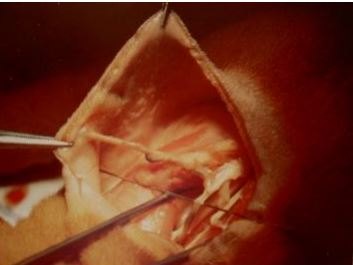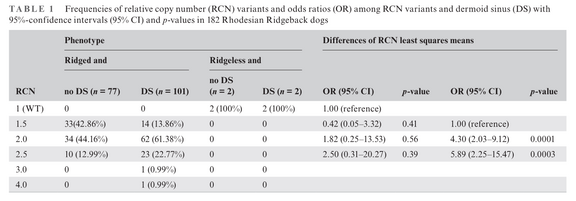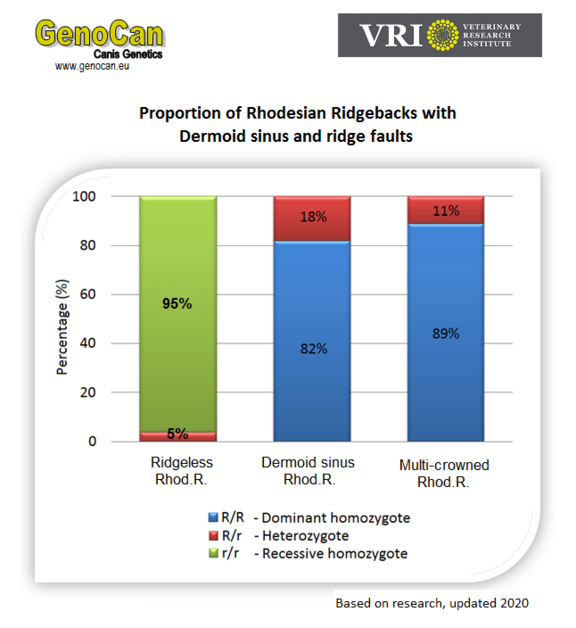Genetic defect DS
DS - Dermoid SinusThe Dermoid Sinus (DS) was already documented in the first publications about the breed Rhodesian Ridgeback (T.C.Hawley - The Origin, History and Standard from 1957).
The Dermoid Sinus is a classic midline defect and is usually located above or/and below the ridge (it also happens that dogs have several DS) along the back. The skin is indented at these points and forms a duct/channel or tube down towards the spine. This structure can extend right up to the spinal column and into the spinal canal, which makes the DS particularly dangerous as it can lead to severe neurological deficits. Surgery for such a DS is also not easy, as it may be necessary to mill into the spine to remove the DS completely.
In this duct, which can be fine but also relatively large in diameter, there are hairs with normal glands. From above, you often don't see much more than a small change in the skin or a few black hairs, but an experienced breeder, breed warden or vet can feel this change. The DS is divided into different stages – stage. I is only in the upper layer of the skin, stage IV extends into the spinal canal.


The DS must be surgically removed as the hairs and sebum-producing glands will otherwise cause inflammation. If the Dermoid Sinus becomes inflamed, a swelling usually forms. If this happens, the inflammation must first be treated with antibiotics before surgery can be performed. This inflammation can be particularly dangerous if the DS extends to the spine.
Nicolette Salmon Hillbertz and her team, including Kerstin Lindblad-Toh (Broad Institute USA and Uppsala University Sweden), studied the Dermoid Sinus in connection with the ridge. They discovered that the dorsal ridge develops when dogs have several copies of a region of the genome containing genes with certain growth factors (FGF). The mutation of this gene leads to a defect in the planar cell polarity system. This system is required both for the normal alignment of the hair follicles and for neural tube closure (if this does not occur, the Dermoid Sinus develops). They also found that the mutation responsible for the dorsal ridge is dominant and that dogs with two copies of the mutation are more prone to Dermoid Sinus than dogs with only one copy.
“The Origin of the Ridge and Associated Anomalies in Rhodesian Ridgeback”- Doctoral thesis Swedish University of Agricultural Sciences Uppsala 2007
The ridge and the Dermoid Sinus risk
The ridge is formed on chromosome 18 by a duplication of four genes (FGF3, FGF4, FGF19 and ORAOV1) and part of a fifth (CCND1) in the order mentioned. Dogs normally have two sets of these genes, one from each parent, which means, that they are genotypically r/r and have no ridge on the back. If there is a duplication (an extra copy of these genes), then the dog will have a ridge.
It has been proven that dogs with ridge have a higher risk of DS. This does not mean that the duplicated gene locus on chromosome 18, which is responsible for the expression of the ridge, is also the only gene locus for the development of DS. There is no question that the inheritance of Dermoid Sinus is a polygenic inheritance and there are probably other (as yet unidentified) risk factors.
The publication by Zhang and Distl (2022) clearly demonstrates that the risk of developing DS correlates with the number of copies of duplicated genes at this location. Dogs with 2 copies (2.0 RCN, genotype R/R) have a 4.3-fold higher risk of developing the disease than dogs with 1.5 copies (genotype R/r). There are apparently dogs with more than 2 copies. RCN 4 means that the dogs have 8 copies. It can also be seen that the DS risk in dogs with 2.5 copies is 5.89 times higher than in dogs with 1.5 copies (penultimate column in the table).


The inheritance of the ridge is probably monogenic autosomal dominant with incomplete penetrance. This means that although the large R is predominant, it does not have to be visually pronounced. This explains the occurrence of ridgeless dogs with the R/r genotype. However, this is extremely rare.
Since ridgeless Ridgebacks with the r/r genotype do not show any duplication, they have a suitable breeding potential to keep the number of copies low and should therefore definitely be used in breeding.
As with many other pedigree dogs, the Rhodesian Ridgeback is subject to constant selection for specific, desirable visual characteristics that have been bred to perfection. This has inevitably led to a loss of genetic variance and, of course, to defective genes.
By breeding the Lionhound and including from the outset dogs that miss the Ridge mutation, we are trying to counteract this. Pushing a mutation into the background in a breed that is a purely cosmetic trait and has no benefit for the animal is more than reasonable and should be understandable for everyone. There are more than enough problems in pedigree dog breeding that need to be solved due to the over-interpretation of the standards.
Genetic test for the Dermoid Sinus?
The inheritance of Dermoid Sinus is a polygenic inheritance.
A genetic test for polygenic inheritance, i.e. diseases caused by the interaction of several genes and environmental influences, is complex and not as simple as for monogenic inherited diseases (a single gene mutation). There is no simple "test" that provides a clear probability of developing such a disease.
Unfortunately, there is no meaningful genetic test for Dermoid Sinus!
